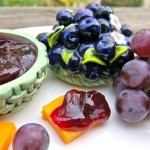Classic Concord Grape Jam
Yield: 2 cups This is effortless in the Thermomix - after preparing the grapes! Instructions without are also included, and it is a straightforward jam
Ingredients
- 500 g prepared Concord grapes
- 1 1/2 cups sugar
- 2 tablespoons lemon juice
Instructions
Prepare the Grapes:
Instructions for the Jam without the Thermomix:
- Add the sugar to the grape mixture and stir until dissolved; add lemon juice
- Bring to a boil, reduce to simmer; stir constantly (skim foam, if necessary)
- Jam should be set in about 15 minutes
- Fill jars with hot mixture, leaving ¼ inch heasdpace
- Wipe the rim clean, centre lid on jar and screw to fingertips tight; do not over tighten
- Store in fridge for up to three months, or process
Instructions for the Jam with the Thermomix:
- Scale all ingredients into TM bowl on R(reverse); set time for 25 minutes, temperature to 100F and speed to 2
- Place teatowel over machine to avoid any splatter; check for set after 20 minutes (cook 5 minutes longer, if needed)
- When set, fill jars with hot mixture, leaving ¼ inch heasdpace
- Wipe the rim clean, centre lid on jar and screw to fingertips tight; do not over tighten
- Store in fridge for up to three months, or process
Processing jam
- Fill canner 2/3 full; bring water to a boil
- Use canning tongs to place jars into hot water; cover canner and bring to a boil for 10 minutes (start counting the 10 minutes when the water starts to boil)
- Turn off heat, remove lid, let the jars sit in water for 5 minutes before removing
- Place jars on a heat-proof surface with canning tongs undisturbed for 24 hours
- Check seals to ensure jars have sealed properly; store in a cool, dark place
How do you know that the jam is set?
- Temperature: apply enough heat to the fruit and sugar to raise the temperature over the boiling point of 212 degrees and alter the structure of the sugar; jam reaches its ideal set point at 220 degrees (a beeping thermometer is great!)
- Sugar: if you reduce the amount of sugar in your recipe too drastically, you may not be able to get your jam to the set point
- Plate Test: take an ice-cube tray (or a frozen plate ready for this test) from the freezer); place a small dollop of jam on it
- After a minute, gently prod the puddle of jam with your finger; if a surface skin seems to be developing a certain solidity, it is done (If it is runny, keep cooking a bit longer)
- Sheet Test: (This is the one Grandma Maude taught me.) Using a wooden spoon, stir the jam and lift it up side ways, or horizontally over the jam and watch the jam drip off of the spoon
- If the drips come together in a fall of the spoon separately, the jam needs to be cooked longer; if the drips join together in a "sheet" or a thick wide drop, the jam is finished
